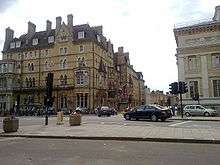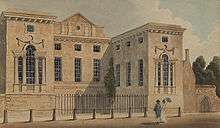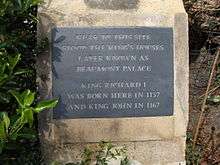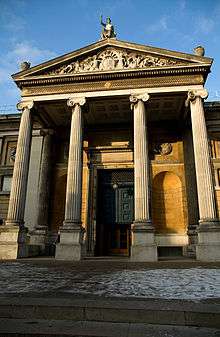Beaumont Street
Beaumont Street is a street in the centre of Oxford, England.

The street was laid out from 1828 to 1837 with elegant terraced houses in the Regency style. Before that, it was the location of Beaumont Palace, now noted by a plaque near the junction with Walton Street. Nikolaus Pevsner considered it "the finest street ensemble of Oxford."[1]
Richard I of England (reign 6 July 1189 – 6 April 1199) and John, King of England (reign 6 April 1199 – 19 October 1216) the sons of Henry II of England were both born at Beaumont Palace in Oxford on 8 September 1157 and 24 December 1166 respectively.[2]
At the western end is Worcester College and the junction with Walton Street to the north and Worcester Street to the south. Halfway along to the north is St John Street. To the south is the Oxford Playhouse, designed by Sir Edward Maufe and built in 1938, where many University productions are held. To the north at the eastern end is the Ashmolean Museum. Opposite the eastern end is the Martyrs' Memorial. Here, Beaumont Street adjoins St Giles' to the north and Magdalen Street to the south. Oxford's foremost hotel, the Randolph, is on the corner with Magdalen Street, designed by William Wilkinson in the Victorian Gothic style and built in 1864.[1] An extension was added in 1952 to the west, designed by J. Hopgood.
The Institute of Archaeology, part of the School of Archaeology in the University of Oxford, was established in 1962 and is located at 36 Beaumont Street.[3]
In poem "Wherefrom",[4] Francis William Bourdillon a British poet and translator wrote about Beaumont Street legend:
Just at the end of Beaumont Street,
In front of Worcester walls,
Strange shrieks of woe the passer greet,
As every footstep falls.
The street is a favoured location for dentists and doctors.[5][6][7]
Gallery
 A 19th century print of the main entrance of Worcester College, which faces down Beaumont Street at the western end.
A 19th century print of the main entrance of Worcester College, which faces down Beaumont Street at the western end. The plaque noting the site of Beaumont Palace.
The plaque noting the site of Beaumont Palace. The Ashmolean Museum main entrance on the north side of Beaumont Street.
The Ashmolean Museum main entrance on the north side of Beaumont Street. The Oxford Playhouse entrance on the south side of Beaumont Street.
The Oxford Playhouse entrance on the south side of Beaumont Street.
References
- Sherwood, Jennifer; Pevsner, Nikolaus (1974). The Buildings of England: Oxfordshire. Penguin Books. pp. 324–325. ISBN 0-14-071045-0.
- Jenkins, Vivian (1996). Kings & Queens. HarperCollins. ISBN 0-00-472295-7.
- Institute of Archaeology, School of Archaeology, University of Oxford, UK.
- "Among the flowers, and other poems by Francis William Bourdillon. 1878. Publisher "Marcus Ward"
- 19 Beaumont Street Surgery — Dr MacLennan & Partners Archived 14 October 2006 at the Wayback Machine.
- 28 Beaumont Street Medical Practice — Drs Sichel and Ferguson.
- 33 Beaumont Street — Specialist Dental Practice, Oxford.
External links
| Wikimedia Commons has media related to Beaumont Street, Oxford. |